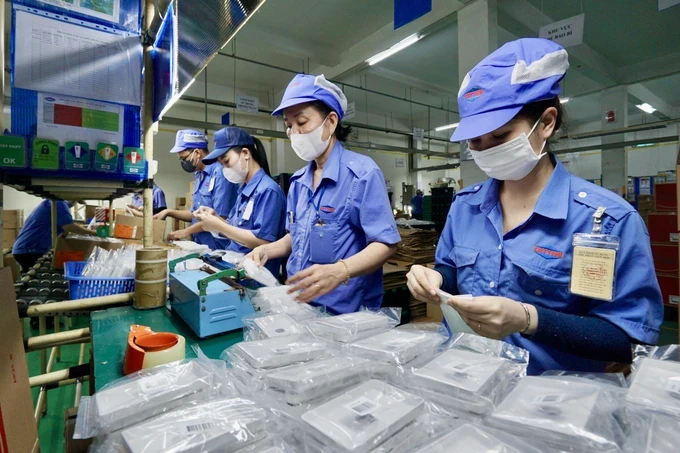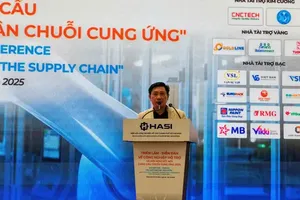
According to Assoc. Prof. Dr. Huynh Dai Phu from HCMC University of Technology (Vietnam National University-HCM), about 60 percent of input material and 90 percent of technological equipment (particularly those with high added value) in supporting industries are imported.
Meanwhile, there is a shortage of high-quality human resources in this field. The HCMC Human Resources Forecast and Labor Market Information Center reported that the labor demand in the chemical, rubber, and plastic industries is about 12,000 employees per year until 2030. Yet the current training system cannot satisfy this need, especially the ones in management positions.
In order to address the three above problems, it is necessary to synchronously carry out seven solutions:
- Industrial clusters to process materials for supporting industries should be constructed in consideration of regional linking.
- There must be more investment in scientific research for advanced manufacturing technologies, with priority to joint studies between universities and businesses.
- Specific policies on intellectual property should be introduced to create a legal corridor for startups, along with the establishment of venture capital funds.
- It is necessary to maintain a strong bond with foreign associations of different industries to form a supply-demand link between domestic companies and FDI enterprises in order to enter global supply chains.
- Heavy investment in research to calculation and certify carbon credits for various product types should be made, followed by support to businesses in the registration for carbon credits for their own merchandise, and thus increasing the competitiveness in the green and circular economy tendency.
- More updates on development trend predictions for all industries should be done so that corresponding strategies (on financial aid, investment, technology, infrastructure) can be timely developed for each industry.
- It is essential to introduce suitable policies to upgrade the quantity as well as quality of the human resources, especially in the rubber and plastic industries, via close links between universities and research centers.
Deputy General Director Nguyen Quang Thanh of the HCMC Finance and Investment State-owned Co. (HFIC) commented that companies from Japan, Thailand, and the Republic of Korea can enjoy preferential loan policies with a low rate of 2-5 percent, not to mention a capital support via each order from FDI enterprises located there. Sadly, domestic businesses in Vietnam have to pay a loan rate of 8-12 percent with no working capital support.
Therefore, to address the above issue, Resolution No.98 by the National Assembly greenlights the reactivation of the investment stimulus program by HFIC, formerly being stopped since 2020.
Also, Resolution No.09 by the HCMC People’s Council stipulates the interest rate support for investment projects with approved loans by HFIC in key areas for the socio-economic growth of HCMC, namely education, healthcare, culture – tourism, industry – supporting industry, agriculture – forestry – fishery, environment – energy, accommodation (exclusive commercial housing), traffic, and other suitable areas for the general socio-economic growth of the city.
In the industry – supporting industry, depending on scale and type, a project can receive a loan rate support for no more than 5 – 7 years and with a volume of no more than VND200 billion (US$8.14 million) per project. The financial aid can come either totally or partially from the city budget.
HFIC is waiting for HCMC to release an official decision on the procedure and budget allocation to resume the program. This is expected to form a strong foundation for businesses to stabilize their market shares and expand more.
Director Bui Ta Hoang Vu of the HCMC Department of Industry and Trade said that one drawback of the supporting industry is a large capital investment but rather slow recovery time and an extremely thin profit margin, leading to higher investment risks. Yet a strong growth of this industry is a solid base for the overall development of the national industry sector.
Hence, the HCMC People’s Committee introduced Decision No.50/2015/ QD-UBND on October 30, 2015 on the city’s investment stimulus program with detailed support policies for this specific industry.
In particular, each enterprise's investment project will enjoy a support interest rate no larger than the average 12-month savings rate (end-of-term payment) of the four commercial banks of Agribank, BIDV, Vietcombank, and Vietinbank, along with an additional management fee of 2 percent a year. The State Bank of Vietnam – HCMC Branch is responsible to update this loan interest rate monthly.
The support time is no longer than 7 years from the first disbursement date. The loan volume is no larger than 70 percent of the basic establishment investment and 85 percent of the capital for technology and equipment. The eligible loan sum is no more than VND100 billion ($4.07 million) per project. Any project asking for more capital or longer support time should request consideration from the municipal People’s Committee.
Until 2020, there were 32 investment projects of 28 businesses in the supporting industry registered for this financial aid, with a total investment of over VND2.3 trillion ($93.58 million). The supported money was VND1.3 trillion ($52.9 million). The average investment capital per project is over VND73 billion ($2.97 million), and the amount of loan supported by the state budget is VND41 billion ($1.67 million) a project.
Calculations show that a state budget allocation of VND460 billion ($18.7 million) for loan interest rate support can attract an investment of VND2.33 trillion ($94.8 million) from businesses sited in the city, which means a successful mobilization from social resources of 5 times that allocation volume.
The reactivation of this helpful program this year under the charge of HFIC is predicted to create more motivation for the city’s economy to develop faster in the upcoming time.
























